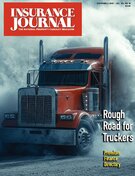Although economic uncertainty could affect insurers in the near to midterm, workers’ compensation continues to be a key driver of the profitability of the entire property/casualty insurance industry even as prices for the line are falling, according to a new AM Best report.
Workers’ comp remained profitable in 2024 with a combined ratio of 88.8–the lowest among the major P/C lines of business–even as net premium written for the industry fell nearly 7% due to rate decreases and pricing cuts, says Best’s aptly titled market report, “Workers’ Compensation Continues With Strong Profits, Despite Pricing Cuts.”
The picture isn’t expected to change. Midyear results indicate 2025 will be another profitable year and another year with a decrease in premium in line with more rate decreases.
Christopher Graham, senior industry analyst, Industry Research and Analytics, AM Best, noted that workers’ comp underwriting profits over the past decade have been largely attributable to favorable prior-year loss development. “While the reserve cushion appears to be shrinking, it is expected to provide benefits to calendar-year profitability in the medium term,” Graham added.
California remains the state with the largest share of national workers’ comp premium, with more than 20% of direct premium written in the country–twice as much as any other state. The top 10 states represent more than 60% of the national premium. According to AM Best, as good as the overall results were in 2024, in six of these top 10 states, results were even better: The statewide combined ratio was better than the national combined ratio.
The report touches on what forces could alter the positive outlook. For one, the segment’s payroll exposure base is susceptible to macroeconomic shocks, the report points out. AM Best sees the possibility of a recession, tariff and immigration policies, and legislative changes as potential headwinds for this line of business.
“A key question for the workers’ compensation line is how much longer will rate and pricing declines continue and cause dissipating profit margins before insurers begin to hold the line on pricing, since, for many companies, workers’ compensation profits help offset more uncertain underwriting results for other lines of coverage,” said David Blades, associate director, Industry Research & Analytics.
In one executive’s view, the workers’ comp market in California may already be headed in a different direction. John Bennett, chief underwriting officer at BindDesk ũ�� Services, recently wrote that while California employers have enjoyed a soft market for the last decade, there are indications of the market hardening. Bennett says workers’ comp rates in California are increasing due to a combination of higher medical costs, more expensive claims, and changes in legal or regulatory requirements. He noted that the California projected accident year combined ratio for 2024 is 127.
Rising costs prompted the Workers’ Compensation ũ�� Rating Bureau of California to propose an 11.2% advisory pure premium rate increase for September 1, 2025. California ũ�� Commissioner Ricardo Lara approved an average 8.7% increase in advisory pure premium rates.
Opportunity Market
Overall, the commercial insurance industry is entering a period of stability and opportunity made possible by an abundance of capital and the power of artificial intelligence (AI), according to another report from global broker Willis.
According to Willis, nearly every commercial line of insurance–except for excess casualty–is in soft market territory. Workers’ comp remains favorable, supported by a $16 billion reserve surplus.
This report finds that insurers, with backing from industry surplus capital exceeding $1 trillion and reinsurance capacity over $725 billion, are pursuing growth across multiple product lines. Capital abundance is only part of the story. Artificial intelligence is “actively reshaping” the industry. “From the boardroom to the underwriting desk, AI-enabled tools are unlocking deeper insights, driving more informed decision making and expanding the very definition of insurability,” the authors contend.
Topics Profit Loss Workers' Compensation Market Property Casualty
Was this article valuable?
Here are more articles you may enjoy.


 AIG to Acquire Renewal Rights of Everest’s Retail Commercial Business Worth $2B
AIG to Acquire Renewal Rights of Everest’s Retail Commercial Business Worth $2B  France Makes New Arrests in Louvre Heist; Jewels Still Not Found
France Makes New Arrests in Louvre Heist; Jewels Still Not Found  PHLY Makes Largest Acquisition in Its History With Collector Car Business Expansion
PHLY Makes Largest Acquisition in Its History With Collector Car Business Expansion  The Hartford Q3 Net Income Up 41%
The Hartford Q3 Net Income Up 41% 


